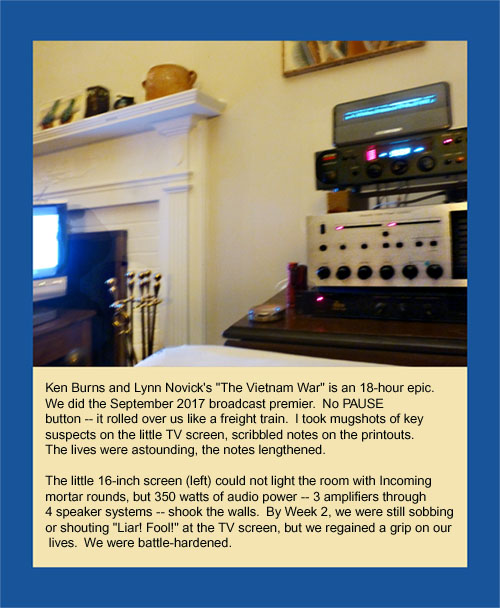bottom & links
Ken Burns & Lynn Novick
"The Vietnam War" in just 18 hours
September 2017
Here are mug shots for the key people,
and enough of their interviews to keep them all straight.
jerry nelson (jerry_stillstanding@nelsonic.org).
2 October 2017
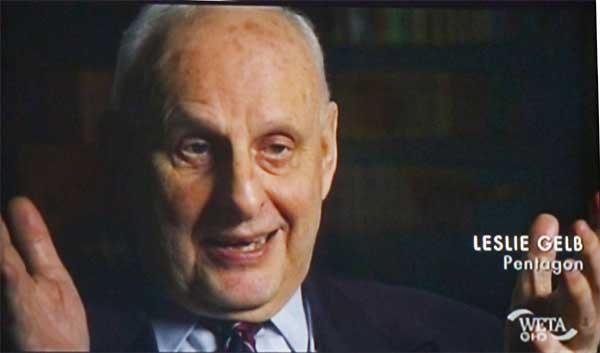
Leslie Gelb led the team that wrote the Pentagon Papers.
Living in the unreality of his own lies frustrated Secretary of
Defense Robert S. McNamara himself. What exactly **was** the
reality around which his lies were always spinning?
McNamara ordered his Second Military Assistant, Army Lieutenant Colonel
Robert G. Gard, to initiate a study into the history of America’s role
in Vietnam, with an emphasis on the internal policy-planning and
decision-making within the U.S. government. The Vietnam Study
Task Force was officially created June 17, 1967 under the direction of
Leslie H. Gelb, the Pentagon's director of "Policy Planning and Arms
Control for International Security Affairs", and completed its work a
year and a half later, January 15, 1969.
Leslie Gelb ran a team of 36 military personnel, historians, and
defense analysts drawn from (and often remaining physically located in)
the RAND Corporation in Santa Monica, California, and the Washington
Institute for Defense Analysis, a "Beltway Bandit" contractor in
Alexandria, VA. Gelb's team called the 7,000 pages in 47 volumes
"United States-Vietnam Relations, 1945–1967: A Study Prepared by the
Department of Defense". We call it the Pentagon Papers. The
time window ends with the aftermath of Vietnam's January, 1968 Tet
offensive.
The Pentagon papers document that every US administration from Harry S.
Truman through Lyndon B. Johnson had knowingly deceived the American
people while understanding themselves that "the criticisms that antiwar
activists had been making for years, not only were not wrong, but in
fact, were not materially different from things that had been argued
inside the U.S. government” (historian John Prados).
IN THE FILM, SOME PEOPLE COME BACK AGAIN & AGAIN, AND SEEM TO PROVIDE GUIDANCE
Here are two of them.
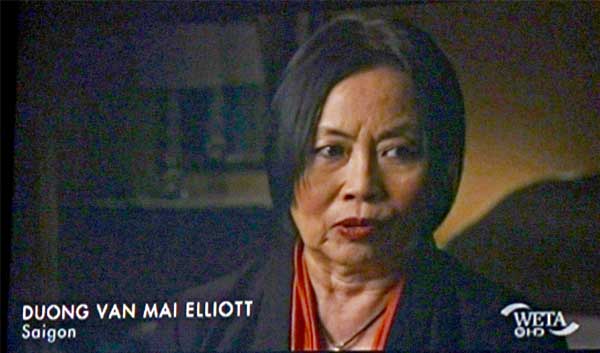
Entrenched
in French colonial rule for generations, this is a member of the ruling
elites. Splitting Vietnam split her family -- she went south, a sister
did not. It was 43 years until the sisters met again, when Mai
Elliott returned to Viet Nam to research her book in 1993. She wrote
"The Sacred Willow: Four Generations in the Life of a Vietnamese
Family".
Rockets were exploding in the city as Saigon fell, when the Americans pulled her family out.
"As refugees, we could find shelter and support from middle-class
friends and relatives, while destitute peasants had to move to squalid
camps and depend on meager handouts and help from the government in
Saigon. But we did find out, as they did, that losing everything was
psychologically wrenching, . . . "
"Only those who have known war can truly appreciate peace. I am one of those people."
"The Sacred Willow: Four Generations in the Life of a Vietnamese
Family" should convince you in fewer than its 496 pages that she is
utterly sincere in that statement.
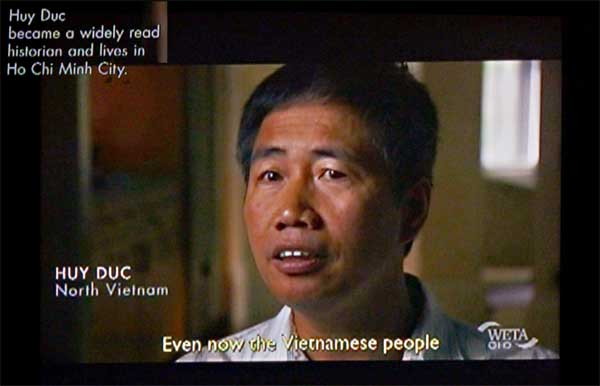
Huy Duc is Truong Huy San (1962- ) a Vietnamese blogger & journalist.
Duc served in the Vietnamese army for eight years before becoming a
journalist in Ho Chi Minh City. Until 2010, he also wrote Osin,
the most popular blog in Vietnam, where his criticism attempted to
"push the line but not cross the line". Nevertheless, he was dismissed
from the state-run Sai Gon Tiep Thi (Saigon Marketing) newspaper in
2009.
Duc studied at the University of Maryland under a Hubert H. Humphrey
Fellowship (2005-2006), and received a Nieman Foundation fellowship for
Journalism in 2012 to Harvard in 2012, where he published "The Winning
Side", describing IN TWO VOLUMES life and the reunification process in
Vietnam. Pre-publication excerpts offered on Duc's Facebook page
circulated widely across the internet.
The name "The Winning Side" is inspired by a quote from Vietnamese poet
Nguyen Duy: "In every war, whichever side wins, after all/ It's the
people who take the fall."
The Vietnamese government has all but officially banned the book.
It ranks as "the first critical, comprehensive history of Vietnam since
1975 by someone inside the country". The VietNamese version is
still electronically downloadable.
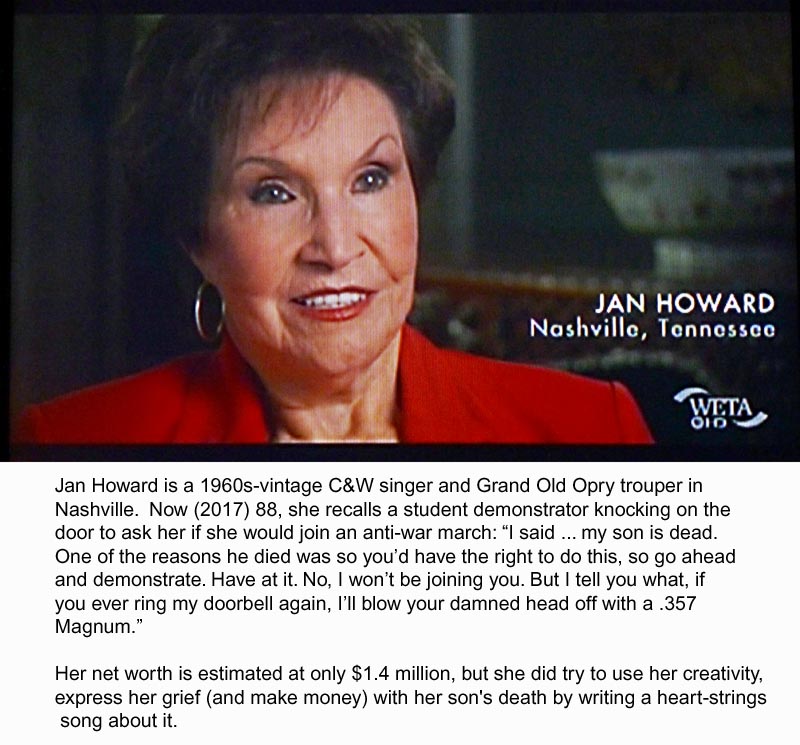
EIGHT U.S. SOLDIERS WHO SAW IT ALL
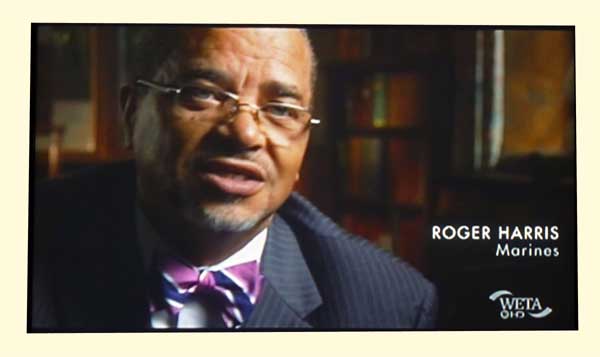
It
was long distance, Asia to Boston, but you could hear his mother
assuring him he would survive because he was special. He told her, Mom,
"I put pieces of special people in bags" all day long. But Mama was
right, he was home at the airport, and there was no taxi for a black
man to Roxbury. Then the National Guard called up, handed him a billy
club and live ammo, wanted him out suppressing rioters. So good
to have you home alive!
" . . . deaths unimaginable. We picked up the pieces of Marine bodies
obliterated by direct hits. We stacked green body bags. I often
wondered why others died and I lived.
"When I returned from Vietnam it was March 1968 in the midst of the
civil rights movement. I landed at Boston’s Logan Airport in my Marine
Corps Alpha Green uniform, with the medals and ribbons I had earned
proudly displayed. I approached the sidewalk to catch a taxi, hoping
that I wasn’t dreaming and would not awaken back at Camp Carroll to
another bombardment.
"Six taxicabs passed me by and drove off. I didn’t realize what was
happening until the state trooper stepped in and told the next driver,
'You have got to take this soldier.' The driver, who was white, looked
up at us through the passenger side window and said, 'I don’t want to
go to Roxbury.' "
. . .a distinguished career, teacher and administrator in
Boston’s public-school system, spearheading a mandatory Mandarin
program for kindergarteners in the city’s largest elementary
school. That led to partnerships with Chinese schools, “So I’ve
been traveling back and forth to China for about six years, and I
meet these beautiful little Chinese kids,” he said. “And when I
return to Boston, looking at these beautiful little American kids, it
concerns me that 10, 15 years from now these same kids could be
fighting each other based on the politics of some policymaker. I
hope that when people watch this film they realize that war is
not the answer."
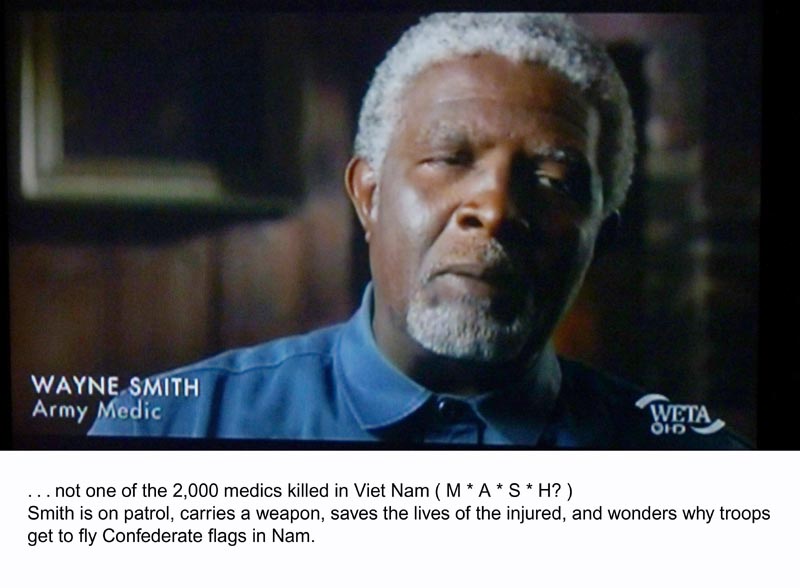
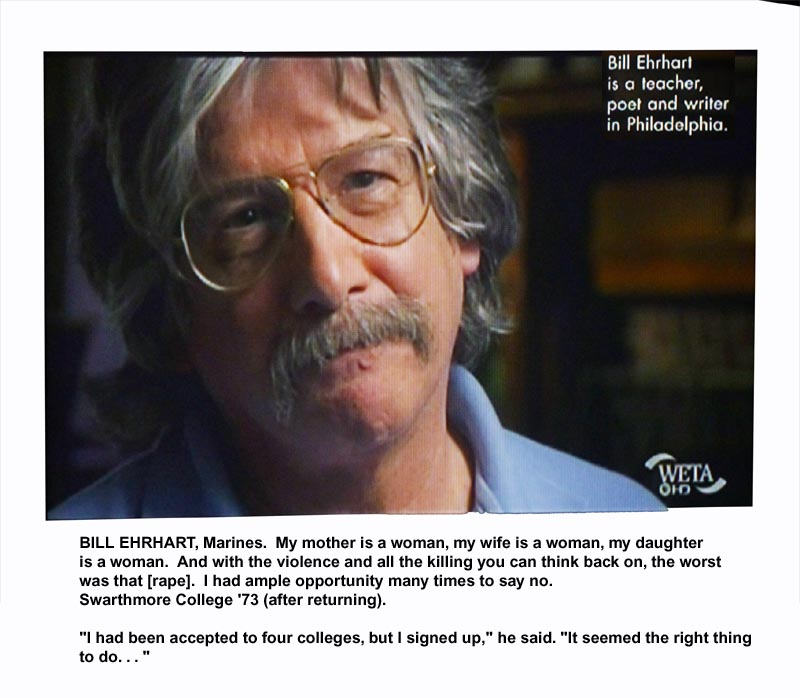
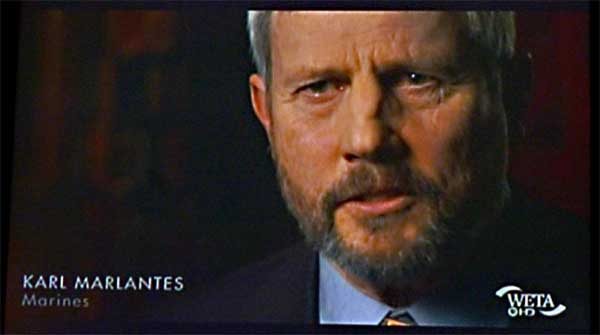
Karl Marlantis quit a Rhodes Scholarship at Oxford to join the Marines
and do others some good as a leader. He led a platoon near the
DMZ.
“I can understand policy errors that kill a lot of people by mistake, but my bitterness is with the lying.
Robert McNamara knew by 1965 the war was unwinable and covering up
killing people for your own ego and that’s what makes me mad.”
Marlantis wrote Matterhorn, a Vietnam War classic. Lost in war of
epic proportions, the boy becomes the man you fight beside, and the man
beside you becomes the person you fight for, that flesh not its skin
color, not the duplicitous officers left behind forever.
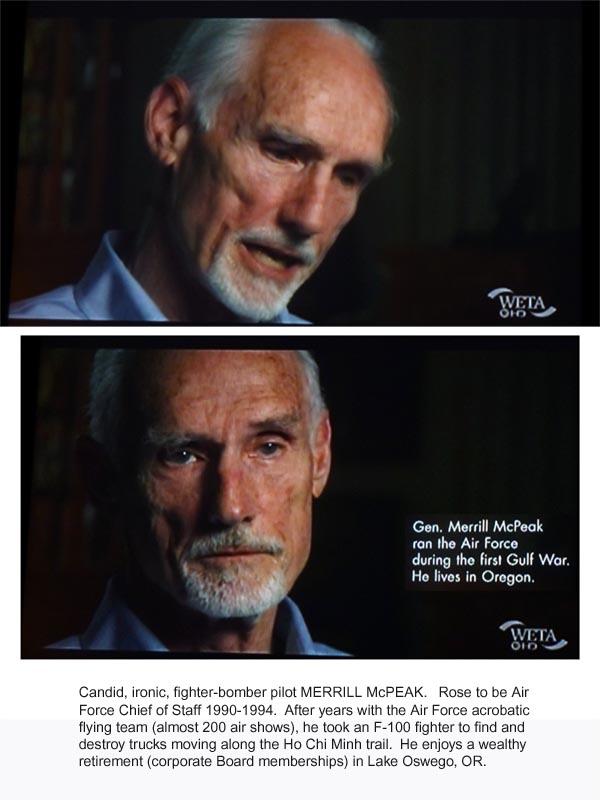
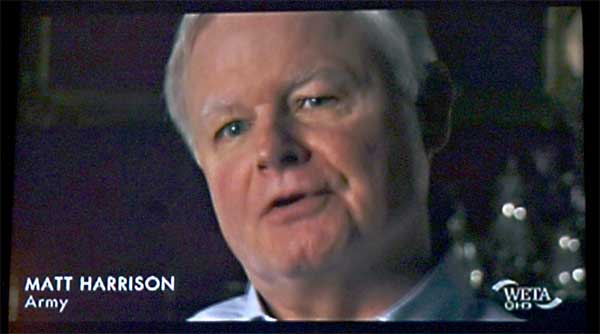
Matt Harrison was born at West Point while his father was serving
there and he himself graduated in 1966 into Army Ranger service. He
winds up in an elite airborne unit known as General Westmoreland's Fire
Brigade.
One of the unit's overnight camp sites turns out to be next to a large
Vietnamese battalion, which pins down Alpha company and Harrison's unit
cannot get to them.
Getting any sleep when you have to hear screams coming from Alpha
Company is not a winner. The next morning, the attackers are done and
gone: 76 of the 137 Americans are dead. Most of us will be willing to
accept Harrison's claim that his memories of putting two of his West
Point classmates into body bags remain vivid.
The enemy took their dead with them; only nine or ten bodies are recovered.
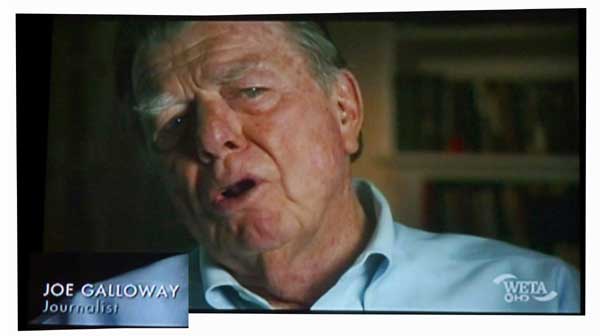
This UPI reporter from Texas could talk his way into anything.
As soon as he collected his credentials in Saigon, he headed for Danang and was at the
Siege of Plei Mei with General Charles Beckwith, who put him in front of a machine gun.
Galloway protested, I'm a civilian non-combatant. Beckwith: “there ain’t no such thing in
these mountains, son.”
Next was Ia Drang. Jets hit two targets, but the second one was a friendly force: a
U.S. company had been hit by napalm. Galloway struggled to pull the nearest soldier to
safety by the boots. The boots came off in a crumble, revealing only bone beneath the
cooked flesh stuck in the boot. Today, "embedded journalists" go where they are told,
when they are permitted.
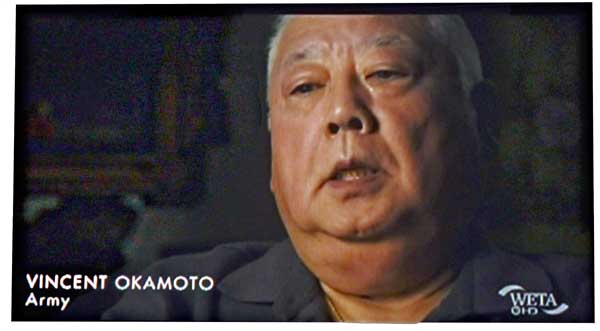
The youngest of ten children, all stuck in a Japanese internment camp during WWII.
The oldest were among the most decorated soldiers of WWII (Italy).
Vincent emerged one of the most highly decorated soldiers of Vietnam.
Pinned down under fire, he ran to one of the unit's disabled armored personnel carriers,
pulled the dead gunner off the weapon, and provided cover for his men until the ammo run out.
He repeated this with the remaining two APCs.
Tired of Army C rations and finding himself in front of a peasant woman cooking rice and fish,
Vincent went black market -- C-rations & cigarettes -- and got himself served food that made sense.
But the quantity being prepared did not make sense, and the women had no answers.
After finding the tunnel and murdering the men in it, he watched which bodies the women wept over,
and how many others had been infiltrators from the north with bonds to no one locally.
IMHO, and regrettably, the atrocities that others on our side fell into
under duress undermine the professionalism of men like
this.
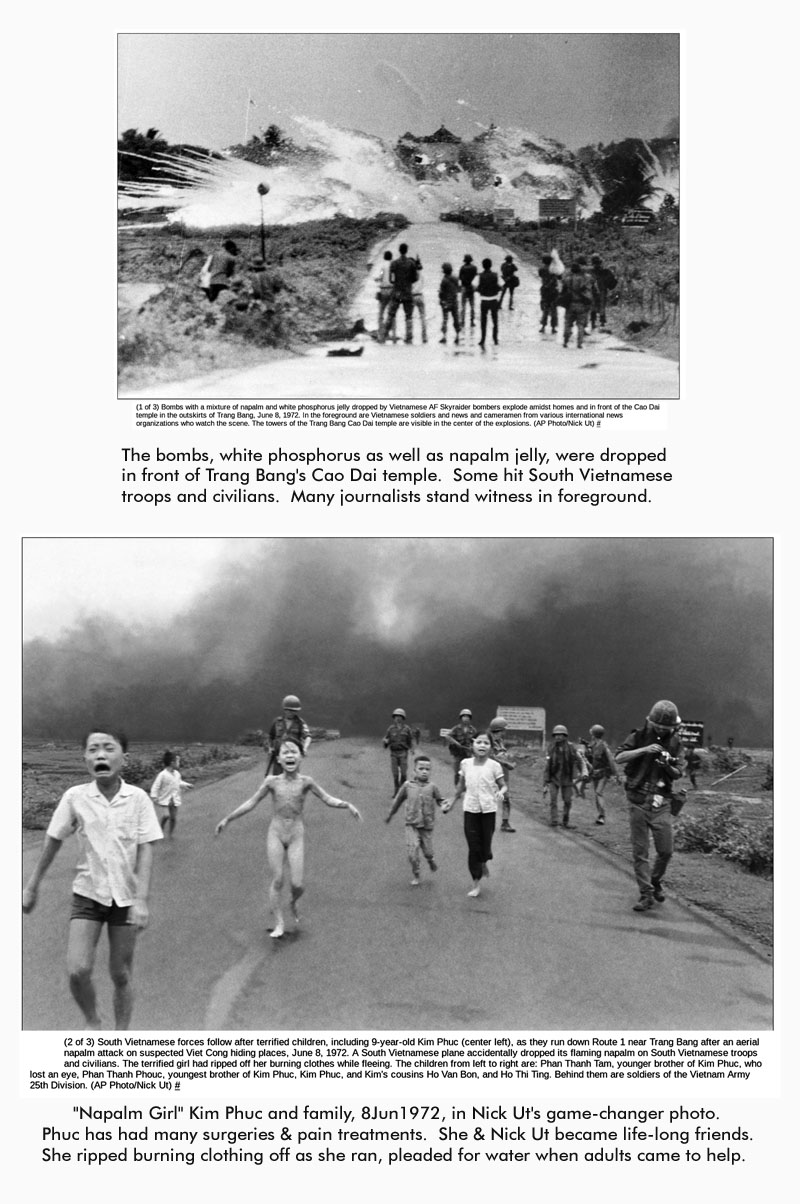
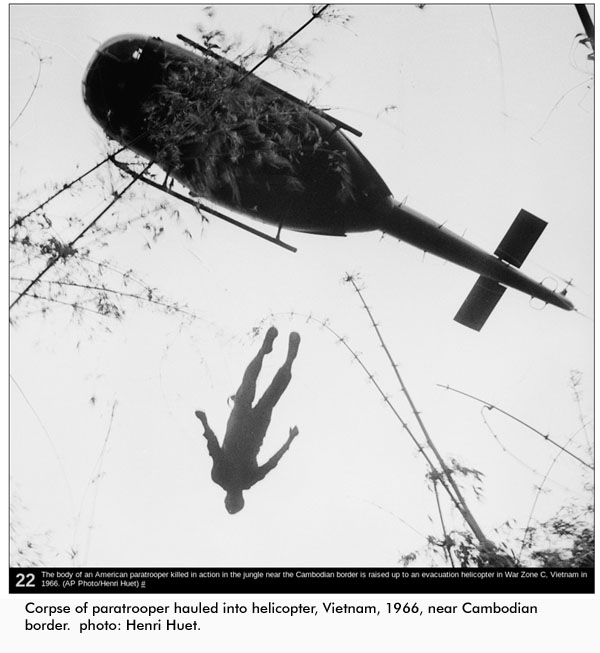
Burns and Novick don't identify the photographers who gave us these images, so many now iconic.
Apparently, the producers thought jamming the screen with credits would be distracting.
But the classic photos, icons of the war, are readily recognized as the work of
Horst Faas,
Larry Burrows,
Eddie Adams,
Tim Page,
Don McCullin,
Henri Huet and
Nick Ut, others.
The war claimed the lives of 135 photojournalists.
A special tribute to Vietnam photojournalists runs in the closing credits.
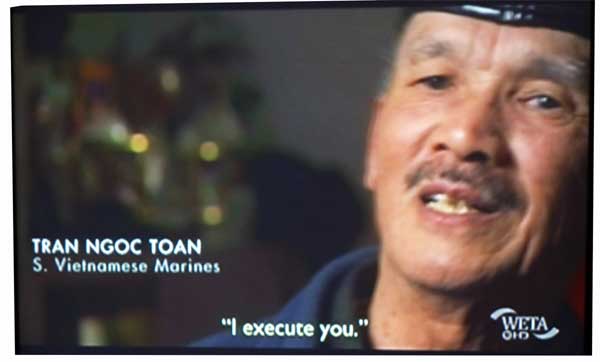
"Execute" -- he's trying to explain why the gun-to-the-head,
middle-of-the-street execution in Eddie Adam's Pulitzer Prize-winning
photo makes sense under the circumstances.
A jolly working-class guy, Ngoc Toan entered the army to escape a
hostile step mother. His home town of Ðà Lat was home to the
Military Academy of Vietnam, and Ngoc Toan got into an elite Vietnamese
Marines unit after graduation.
Two years later, Ngoc Toan was partnered with US Army Lieutenant and
later US AID officer Phil Brady. Brady was so tall and fair-haired,
Ngoc Toan was sure walking with him would make both of them sniper
targets. Ngoc Toan has adopted the kidding-around style of the
marines, but beneath the smiles lies fierce loyalty.
Sent 28Dec1964 to liberate Binh Gia, a US helicopter was shot down over
the town, killing four Americans aboard. While trying to
retrieve the American dead, local Viet Cong killed 12 of the men in
Toan’s battalion. Then another US chopper dropped in to take American
dead and wounded, new and old. But it took no Vietnamese, none who had
lost so many of their own, trying to erase the initial loss. The
South Vietnamese troops waited three hours for a helicopter to come get
their dead and wounded.
It never came.
VC started shelling the group, and shelling grew into a full assault.
Ngoc Toan was wounded the calf, kept fighting, crawled away when it
grew dark and played dead. A VC soldier mopping up shot him
another three times just to be sure, but two shots missed. He'll show
you the next wound if you ask.
After the VC had gone, Ngoc Toan crawled back toward Binh Gia – three
days later, the South Vietnamese Army found him, bugs crawling in his
open wounds, but alive.
Tran Ngoc Toan lives in Texas (Washington DC was too goddamn cold in
winter). He earned his first US money as a house painter (San
Francisco), then in the Washington Post printing plant. He now
lives comfortably, if very modestly, in Houston. He asks us to
remember to 300,000 South Vietnamese who died on the American side
(some historians will say 250,000, but you can add in two million
civilians -- north and south -- to round it up).
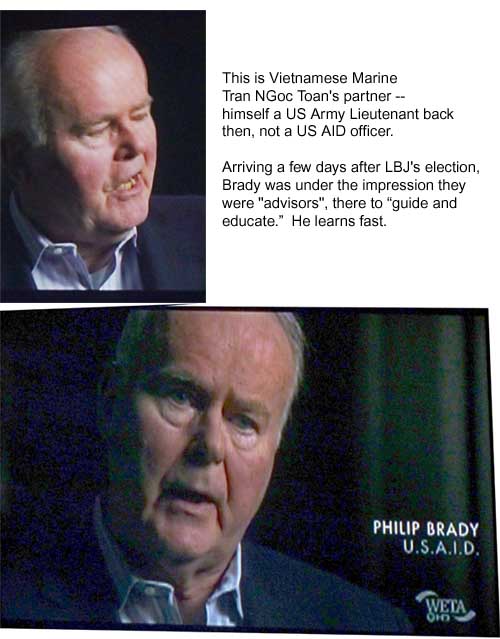
SOME on the NORTH VIETNAMESE SIDE
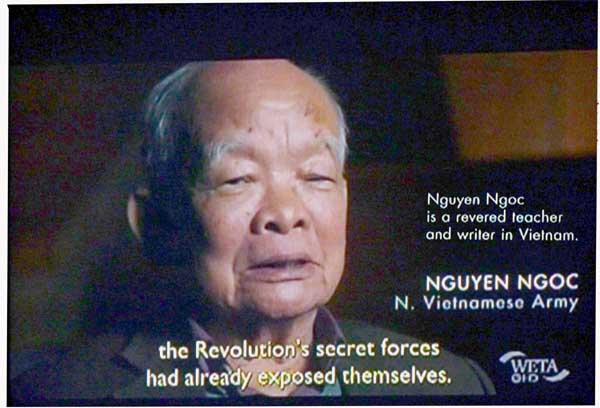
Like
Cubans during the Bay of Pigs (April 1961), the South Vietnamese would
rise up during the Tet Offensive (30Jan1968) -- "the Revolution".
But they didn't.
The spies (civilian) and Viet Cong (military) set out to rouse the
urban proletariat, and kill the puppet rulers. "...the
Revolution's secret forces had already exposed themselves", coming out
of cover to launch the Tet offensive. But the Tet offensive was
failing, and he never said, We had to flee for our lives, the civilians
knew who we were, our true allegiances. So we killed them all,
the graves weren't so good, no time, you found them so soon. I
hope your understand.
JIN: In the biographic squib that Ngoc would have approved, the central
word is "revered", a revered teacher. This man speaks with clear
attention to social standing in the world as he finds it, not as it
might be, the better world he might have once hoped for, a world he
learned with his personal, leadership, and intellectual skills to kill
for.
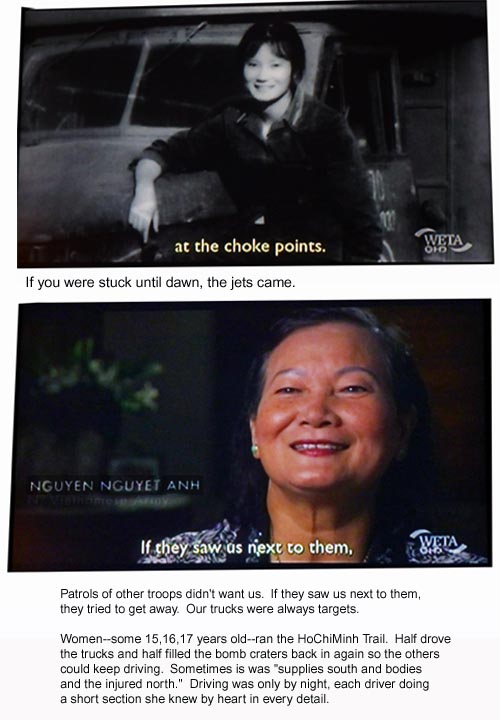
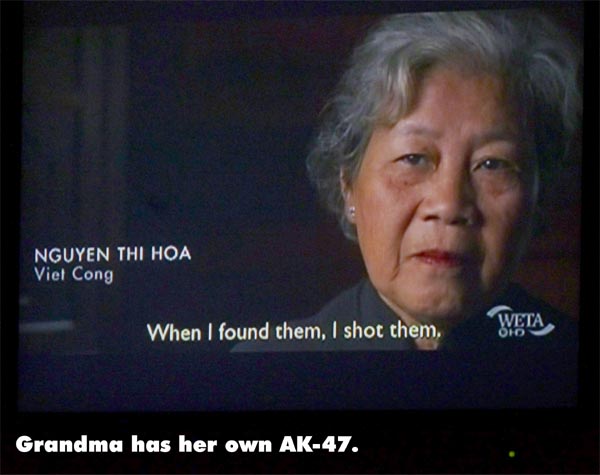
Urban embedded Viet Cong rose up with the start of the Jan 1968 Tet offensive.
Nguyen Thi Hoa was about 19, and in Hue, with the worst house-to-house fighting and
mass graves of murdered civilians.
"When the American soldiers fell down and died, three or four others would jump in to
carry the body away, crying. They did not have any experience in fighting at all
although they had been taking over the war in this area ever since 1968.
So we took advantage of the situation to kill the rest of the group.
By around five o’clock, we girls were able to establish contact between the stadium and
the Cho Cam market forces . . . "
JIN: the tenor of her quotes suggests a desire to position herself politically,
and use her life as theater.

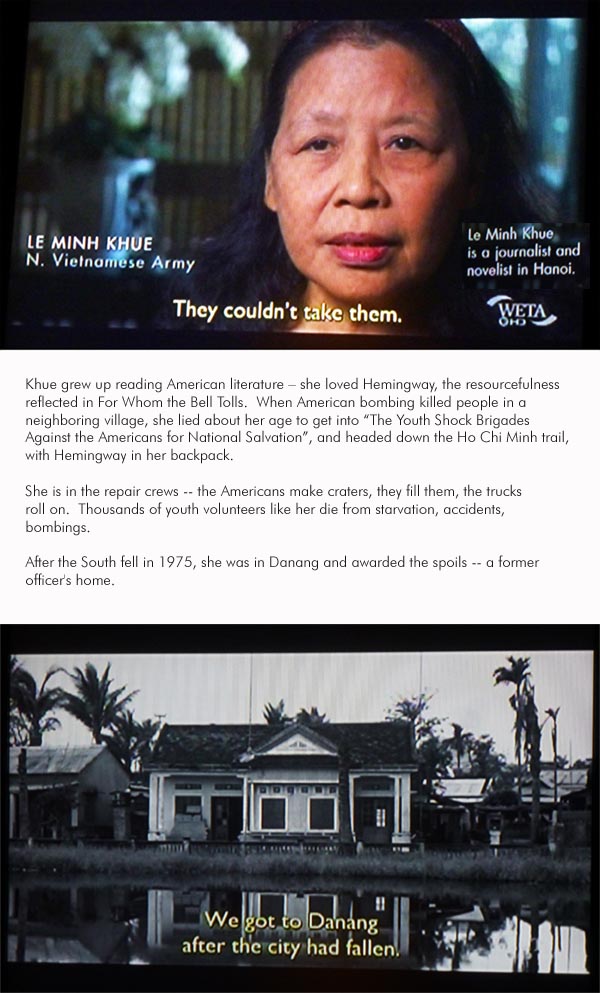
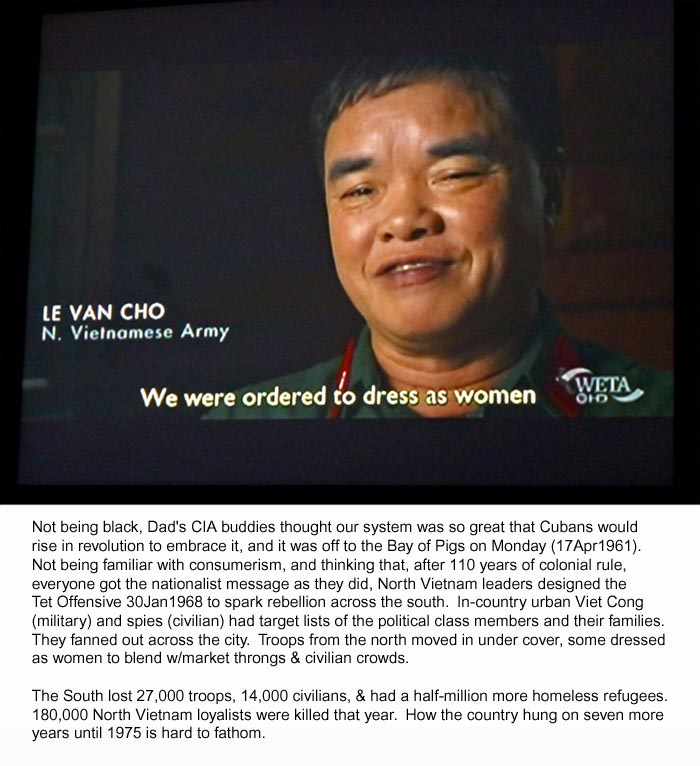
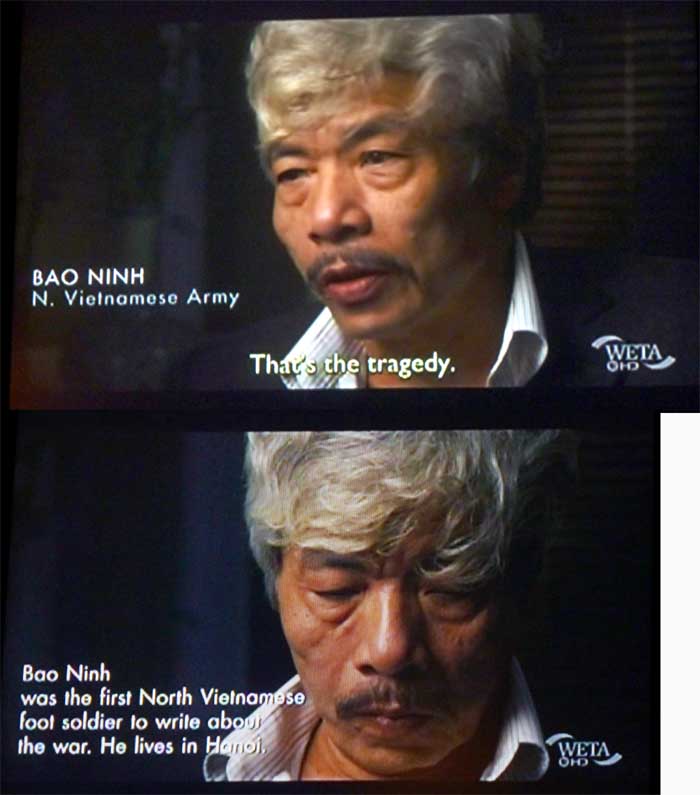
Author of "The Sorrow of War," 1990. Bao served in the Glorious 27th Youth Brigade.
Of the five hundred who went to war with the brigade in 1969, he is one of ten who survived.
The North Vietnamese Central Highlands brought bombings, napalm and starvation.
Cannibalism, no, but they rolled American corpses looking for food.
Most of the men in his unit desert at one point or another to go home. They have never
had a woman; if a boy wants to go home to his mother, nothing will stop him, they walk
north hundreds of miles, always north. Ninh claims a live-and-let-live culture of desertion:
most returned after suppressing their homesickness.
In his hometown Hanoi apartment building, six were drafted, one has returned.
His mother weeps with the rest of them. Nothing else would be appropriate.
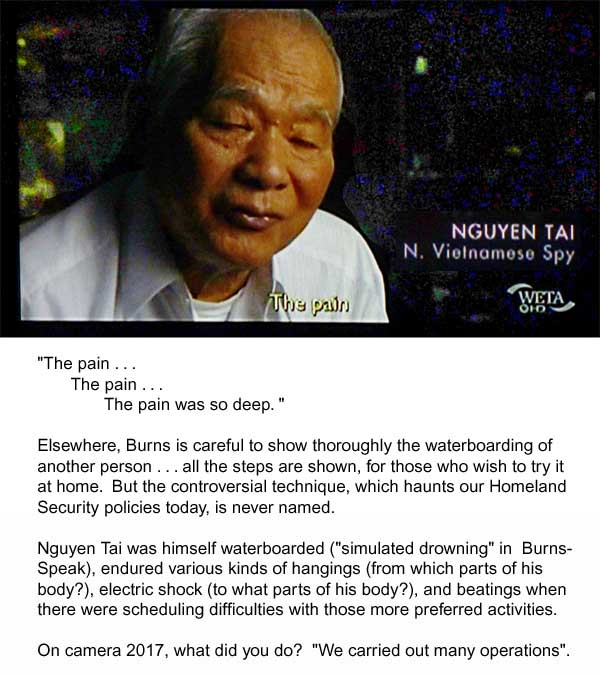
THE CENTRAL FIGURE: JOHN MUSGRAVE
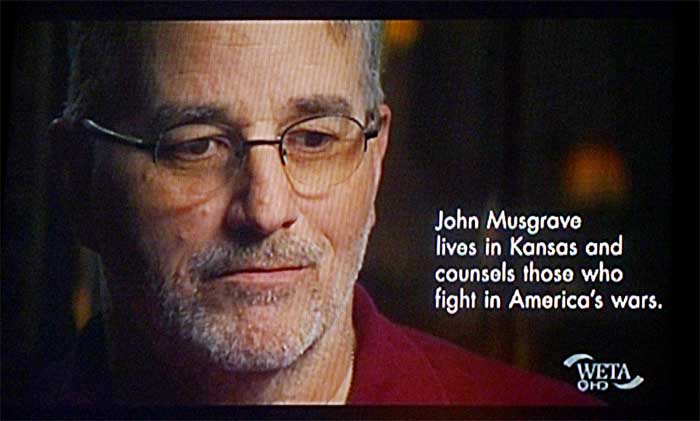
John Musgrave emerges as a central figure, everything visited upon
him but death itself. His life hurtles from an obvious set of values to
none at all, lost as the country was. It takes honesty to rebuild, and
that's how he eventually succeeded while the country still struggles.
John Musgrave and his best friend enlist together when they turn 17 --
this is how you grow up, this is what Dad did in WWII. All the
grownups are vets, all are white, and basic training confronts Musgrave
with the first blacks he's ever seen -- hometown Kansas City knows how
to hide them. Dad was a pilot but he'll be a Marine, he'll fight
the Communists directly. Next stop, Viet Nam, The DMZ, Dead Marine Zone.
Musgrave’s company's sweep of the countryside leads to ambush and he's
the first to fall. When a fellow Marine tries to rescue him, it is
Musgrave that is shot again. With a hole the size of a fist in his
chest, he’s dragged from the jungle, his fellow marines sometimes using
their own bodies to shield him from further attack.
This is not a limb injury -- the hole is in his chest, the lungs are
pierced, and blood doesn't get redder than when it's just been
oxygenated. Blood pressure hasn't failed yet, Musgrave is
conscious as medics look him over and turn away. A field hospital
must set priorities, he has been triaged twice. The third one asks what
is your religious affiliation. "Protestant." "Get a chaplain over
here." The fourth medic shouts out, "Why isn't someone helping
this man?" Finally he dares to relax, and wakes in an Intensive
Care Unit days later, his life and memories intact, and tells us
today, I was shot early in the battle, "that's why I'm here
today". But it was 17 months in Navy hospitals for him, until his
life could resume.
Home and in college (Baker University, Baldwin City, Kansas) the
antiwar movement has seen the Mai Lai Massacre and the "baby killer"
cry is out. War is a lot to explain, and first you must fashion
the explanation to yourself -- harder when heartbroken, so hopeless
that Musgrave tries to claw his way back to Vietnam with a body so
broken they won't take him again. Yes, he can be a recruiting
officer, and here he is still home, facing protester attacks on
recruiting stations. Questioned to his face by antiwar activists
with possibilities as new to him as blacks in basic training, he starts
reading up on the How and Why of U.S. involvement in Vietnam. The
rational result, familiar to many of us, is an impulse to kill yourself
over such ill-conceived national insanity, only Musgrave has the gun.
Nixon’s troop withdrawals finally settled John Musgrave's life: if it’s
not worth winning, it’s not worth dying for. That war wasted life and
death itself. His parents, the uncles and everyone back home will
have to accept what henceforth will be a lifelong opposition to such
service.
I have listened to and watched him. I find John Musgrave amply
qualified for psychological counseling of others. He worked with The
Theater of War, reading Sophocles’ Ajax and Philoctetes to military
audiences, and it was there that Lynn Novick discovered him in 2012 (he
is no longer on the cast). These Greek tragedies were likely read by
warriors for warriors as a ritual to deal with battle stress, as a
ritualized, reliable way for the community to welcome returning
soldiers and bring them back into civic society. If you thought classic
Greek literature had nothing to do with us, have another look.
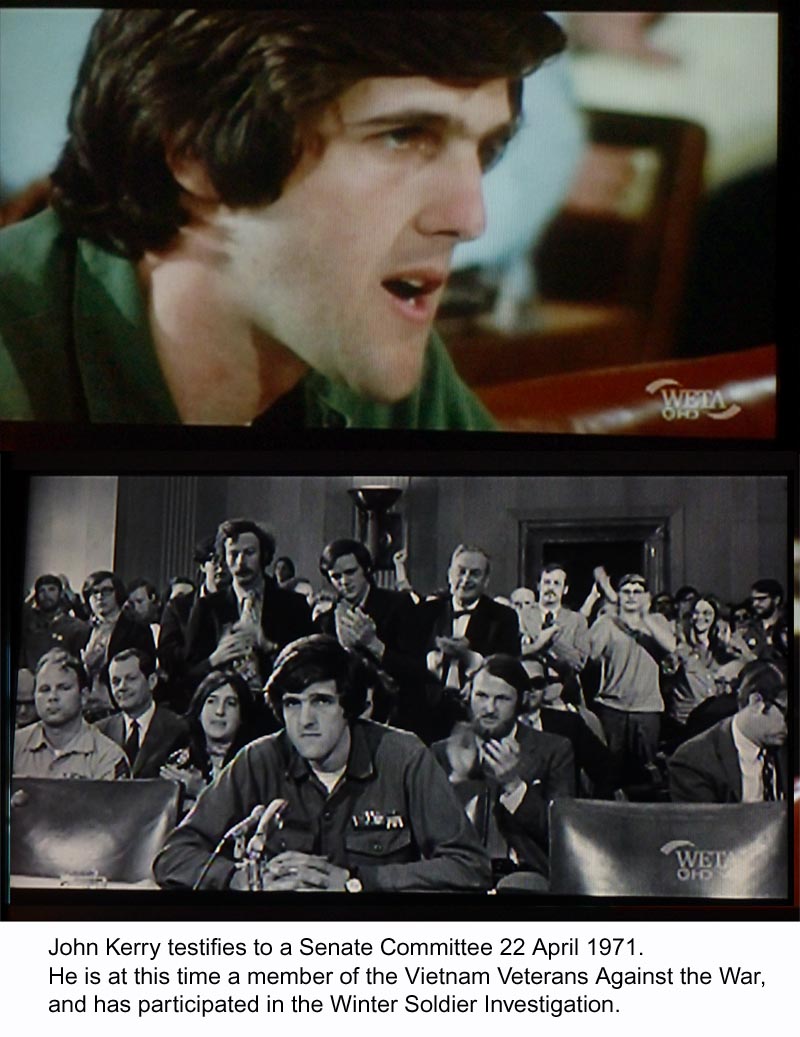
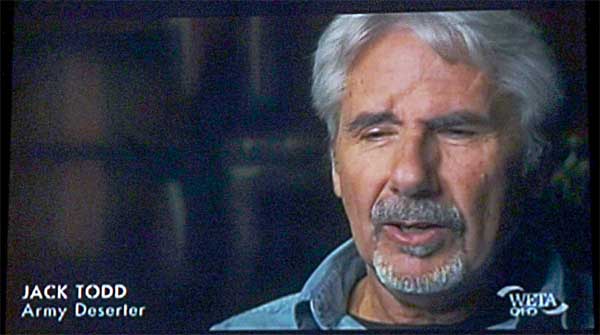
Jack
went for Marine officer training while still in school (University of
Nebraska), but was eventually forced out with bad knees. Slowly,
he came to question the war itself.
Now a reporter at the Miami Herald, up pops a draft notice (autumn
'69). When he hands over his Marine discharge papers, they tell
him that was then, this is now: you were discharged from an officer
program in the Marines, we're drafting you into the Army.
Morale at Basic Training in Fort Lewis, state of Washington, is awful, officers and men both.
Conscientious objector status doesn't work for agnostics, and now he's
fleeing to Canada (Vancouver), a deserter because his induction
physical exam had already started. At least he gets employment as
a reporter, earning him landed immigrant status on the way to Canadian
citizenship, a path only one in four American refugees could follow.
Sick for news of the people at home who will not write to him, a letter
from his mother finally does arrive, with a hometown newspaper clipping
that his boyhood friend from down the street has died in Vietnam.
What has doing the right thing gained for him? Where to now?
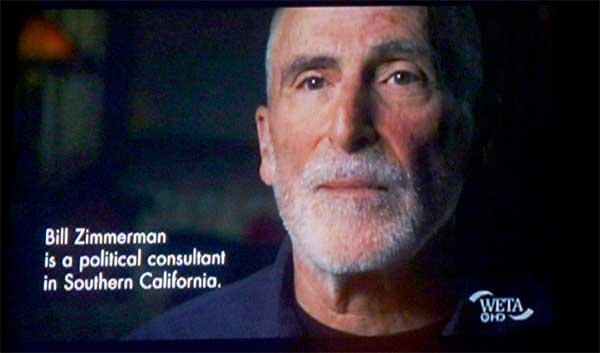
Bill,
the son of Eastern European Jews who escaped the Holocaust, worked for
civil rights in the South and opposed the war since 1963.
The University of Chicago administration sends class ranks to the DoD,
and students are drafted when their grades fall. Zimmerman's
fellow protesters stop the practice, but a demonstration against Dow
Chemical for their explosives and Agent Orange manufacture draws only
50 people. Why do this again at the Pentagon in 1967? But
50,000 show up, and the Pentagon set up a defense perimeter -- the
first time antiwar demonstrators had confronted active duty
personnel. For protesters, the government was the enemy of the
people, and the troops confronting them were victims of the system.
ROTTEN TREES FALL OVER
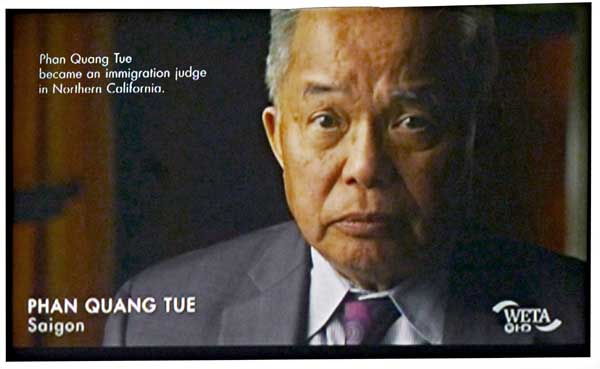
Phan Quang Tue struck me as highly placed, with government connections . . . good comments
on Saigon power plays and rivalries.
It turns out Tue was a law student, Catholic, and jailed when protesting against the Diem government.
Diem found it helpful to also jail Tue's father, a prominent nationalist, since calls
for more democracy did not fit well with the government structures that Americans typically
architect, at least in these earlier stages of bringing democracy (elections ! ) to benighted souls.
Phan's crimes included openly protesting with Buddhists for a more just and inclusive South
Vietnamese society. He was tortured in prison.
I presume that today, as an immigration judge in California, Phan Quang Tue will have to deal
with President Trump's efforts to build a more just and inclusive North American society.
A society that is inclusive and just sustains its stability. A country having trouble maintaining
a stable society at home will have trouble building one overseas: Vietnam, Iraq, Afghanistan.
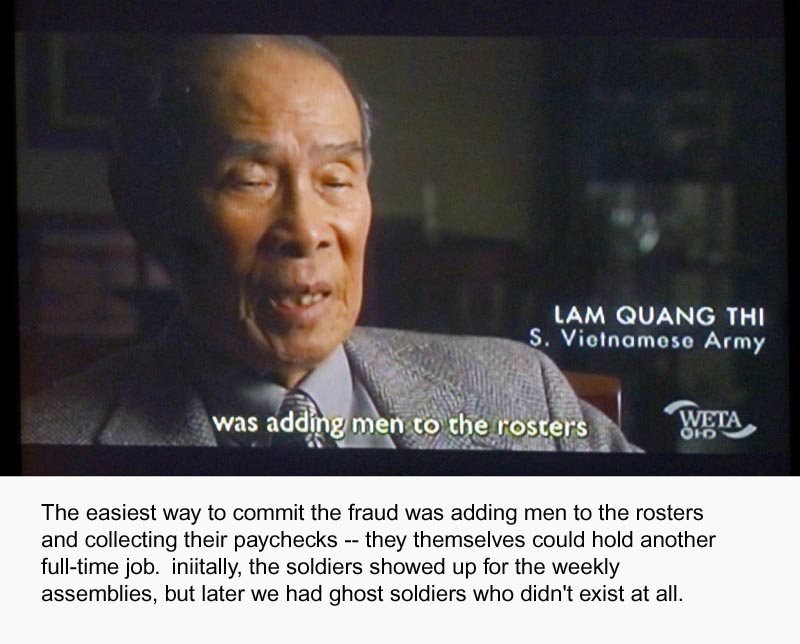
IT'S HELICOPTER TIME
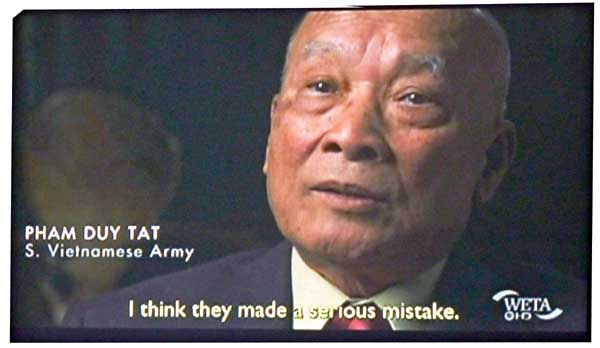
Duy Tat was high enough in rank to have a "command helicopter" and pilot. Rather than flee, he decided to stay.
Suicide?
Many others did. But the Catholic religion condemns suicide, a
problem that has never left the families of the 911 North Tower
jumpers, 1344 people trapped above the point of impact, with no
passable stairway down. The way they chose to take control of their own
lives saved thousands in the South Tower, saved the five to seven
thousands who had seen enough and left in time even as their superiors
ordered them to stay.
As a former officer, Pham Duy Tat's attendance at a Vietnamese
"reeducation camp" (forced labor) was obvious. Not obvious to anyone
was the fact that he would stay seventeen and a half years and be
among the last to get out (autumn 1982), as Vietnam struggled for
normalization of world relations and economic growth.
"I think they made a serious mistake" is Pham Duy Tat's comment on the
disastrous Tet offensive, with its call, "Rise up, urban proletariat"
to the South Vietnamese, who did not foment revolution after all, who
did not rise to throw off their puppet masters.
"I think they made a serious mistake" seems also to be a comment on
those who believed 17 and a half years of forced labor in a detention
camp would engender love and blindness towards those who coerced it.
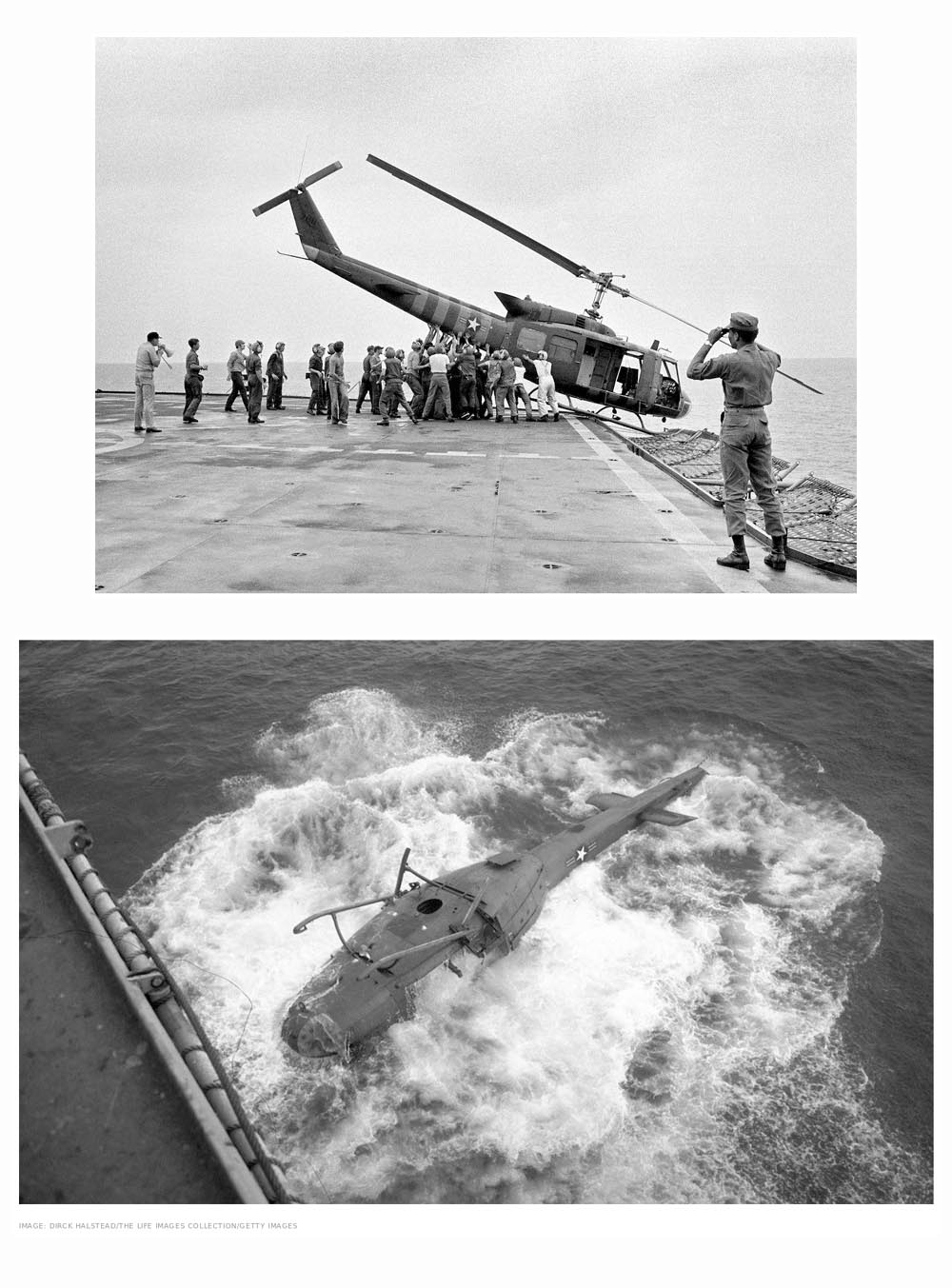
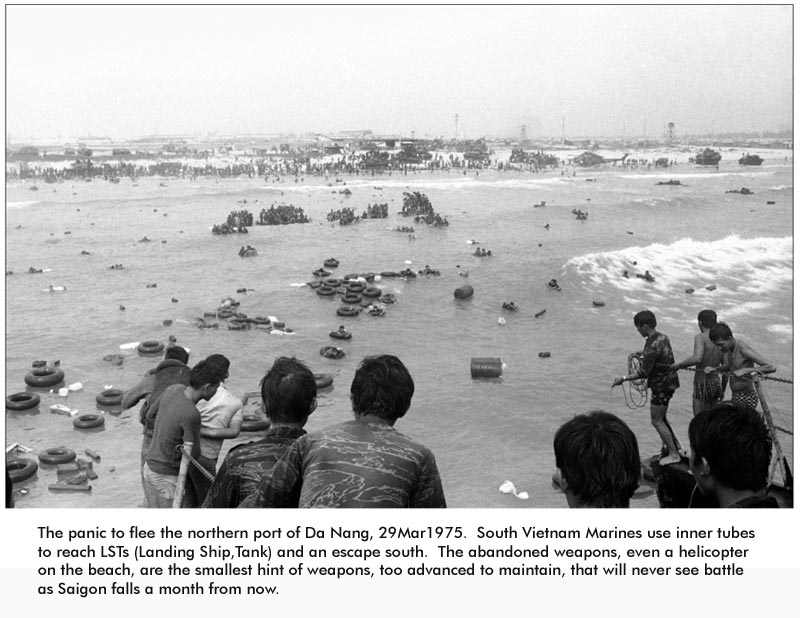
BATTLE TRAUMA, POWs, ABANDONED CHILDREN
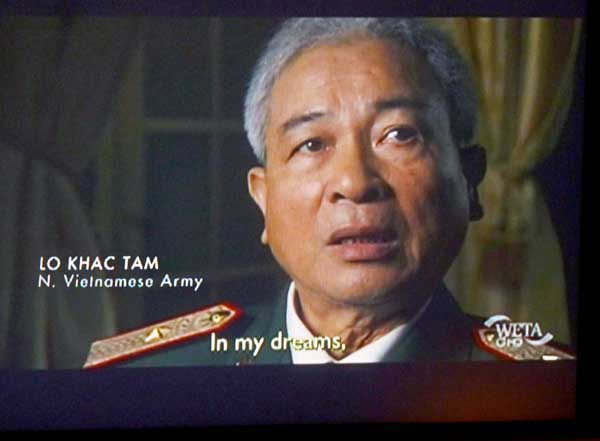
"In my dreams I'm haunted by brutal scenes of war and death.
I think it's because I haven't fulfilled my obligation."
One-third to one half the men under his command never returned.
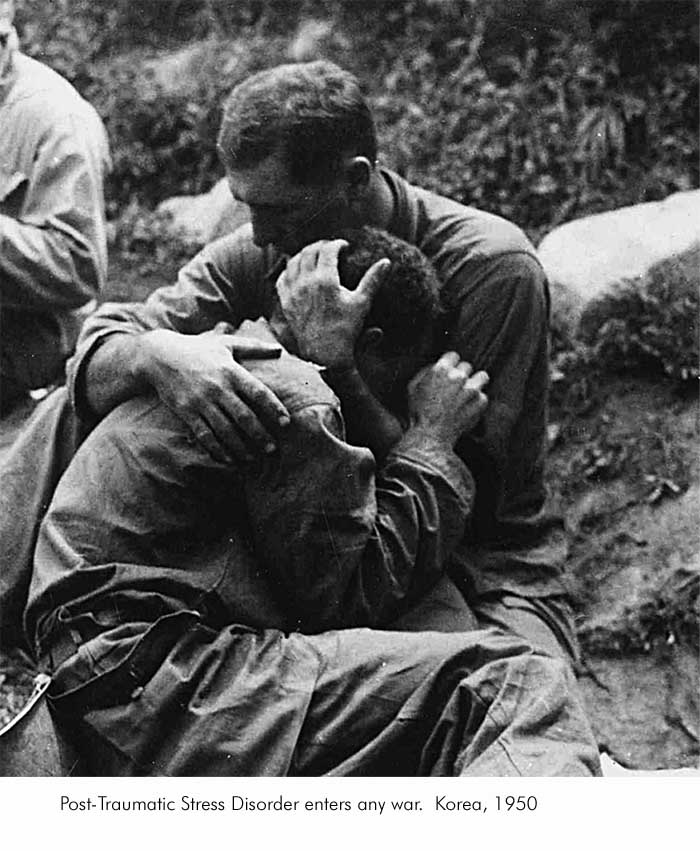
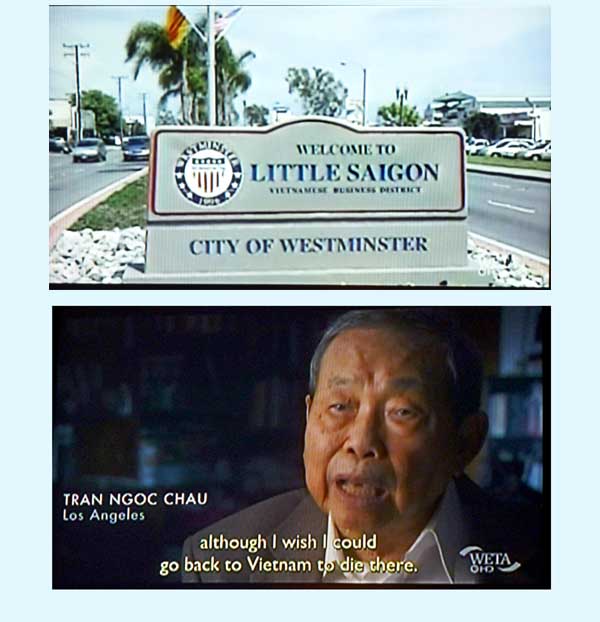
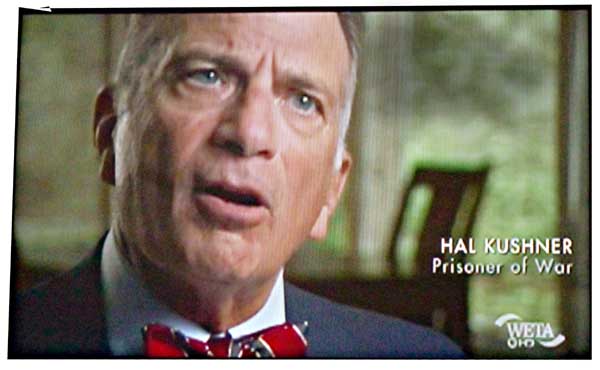
. . . but someone didn't bury a paw, and the guard knew we had killed the captain's cat.
There were beatings. We never got to eat the cat.
I was the only MD held as a POW & I myself needed surgery after the helicopter crash.
The doctor, a woman, gave me a piece of bamboo to clench in my teeth. Surgery with a red hot knife is always sterile.
"Once home, I saw television and movies with frank profanity and sex.
When I left, Lucy and Desi slept in twin beds.
"This war, which had such a great impact on my life, is a dim memory today.
There are 58,000 names on that wall, and it rates but a few pages in a high school history book."
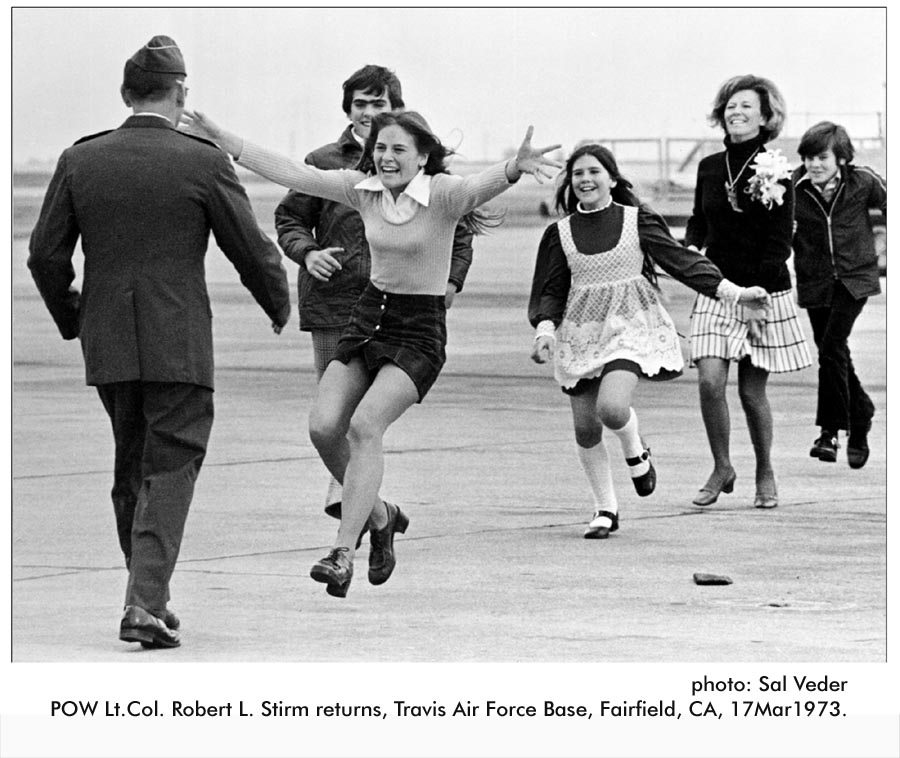

If the mother marries again, the Amerasian boy is the bastard the
stepfather beats, until an aunt explains it to him, because the mother
will never find the courage and character to do it herself. Most
Amerasians are bullied into leaving school early, live on the margins,
find only menial jobs. Even their own children will still have
grandfather's wrong hair, and have to hope the world will globalize
soon.
Many were given up for adoption by frightened parents, and indeed
"re-education classes" (forced labor camps) were often imposed on
mother and child alike. Others were caught in the Communists misguided
"collectivization" of agriculture and sent into rural farm labor.
Some mothers found suicide to be the safest future.
As a child, Nguyen Thi Thuy tended a herd of water buffalo on her
adopted family's farm. The animals were her only friends, she says
today. The step family made her work long hours in the fields,
Thuy said. She loved school and managed to stay on until 12th grade but
had to drop out because she didn't have the funds for the required
school uniform. She found apprenticeship as a tailor and then
opened her own shop in a small kiosk. She married a laborer who loved
her and said he did not care she was Amerasian. They had two girls, now
12 and 14.
Thuy, now 42, had gone looking for her birth mother when she was about
18 and found her in a town about an hour away. "How did you find your
way here?" She wanted no part of her past or her daughter. The
two have a maintained a distant and complicated relationship ever since.
Amerasian children have sometimes found their fathers, some fathers are
happy to find them, but it is hard when your mother burned all photos
and letters lest the Communists find them. An Amerasian
resettlement program ("American Homecoming Act") was started in 1989,
but getting papers is hard when you have no birth records, no identity
proof to begin with. One Amerasian has saved her old American
visa application, with "does not appear Am/no proof American father"
scrawled across the rejected papers returned to her. For a
lifetime of racial discrimination, no proof is required.
Sometimes relatives of couples going back as lovers are invited to come
also. Sometimes Fatherfounded.org can help. Estimates of Stateside
Amerasians who find the father stand at about three in a hundred cases.
Dads would rather forget it.
For many, the happiest solution is marriage with another
Amerasian. They have no family in a family-oriented culture.
Better to be alone together than alone completely.
The Amerasian issue was not tackled by Ken Burns and Lynn Novick in
their Vietnam War documentary -- it is a part of Vietnam's untold
reconstruction story.
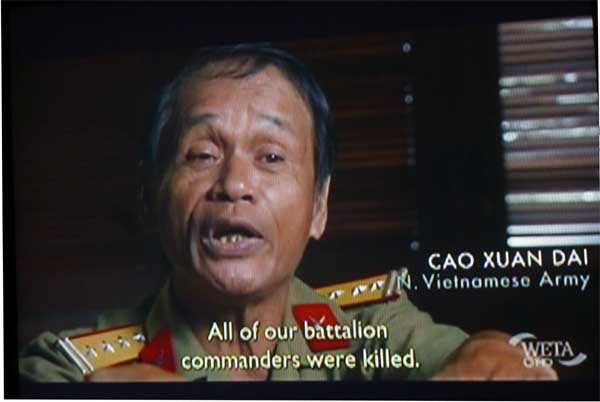
Newsweek reports that powerful figures in the Hanoi government are not happy
with the series to such an the extent that they ousted foreign ministry press officers
who helped Burns and Novick set up interviews.
Leaders’ primary complaint is reported to be that the series exposed dissension
and rivalries throughout the war at the top levels of the Hanoi regime.
They are also annoyed that several interviewed Vietnamese spoke frankly about
the massacre of civilians in Hue during the Tet offensive, 31Jan1968-early Feb.
In the past, the North Vietnamese blamed the deaths on American bombs and artillery.
But so many mass graves were scattered across Hue, that another one was found only in 1970.
Although PBS devoted considerable time and expense to create a Vietnamese-language
version of the series, no one expects the government to allow it to be shown in Vietnam.
--Don North, ConsortiumNews
LAST ONE OUT, TURN OFF THE LIGHTS
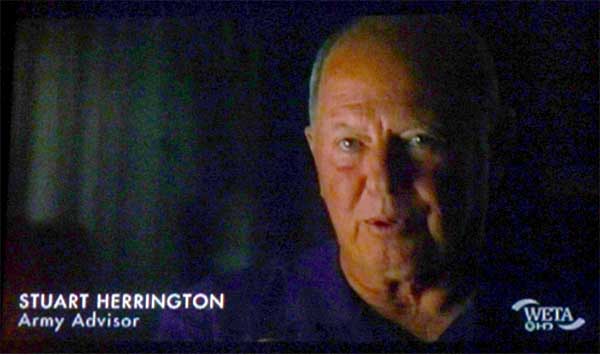
Saigon will be Ho Chi Minh City in 5 hours,
the terrified Vietnamese have broken into the US Embassy compound,
but there is no way any of them can be gotten out of the country.
Herrington's job is to lie to all of them ("Army Adviser" = CIA, speaks the language)
until he can escape without any of them.
He will excuse himself to pee, head into the landscaping and sneak around to a back door
and up to the roof to escape without them.
In this business, you don't order anyone to kill someone.
You terminate them with extreme prejudice.
You don't ask Herrington to lie to the Vietnamese.
He was asked to keep them warm.
Herrington is not proud of what he had to do.
We are not proud of what we asked him to do.
Civilians finally breaking through to the heliport door were held off by teargas,
enough to almost disable the departing pilot.
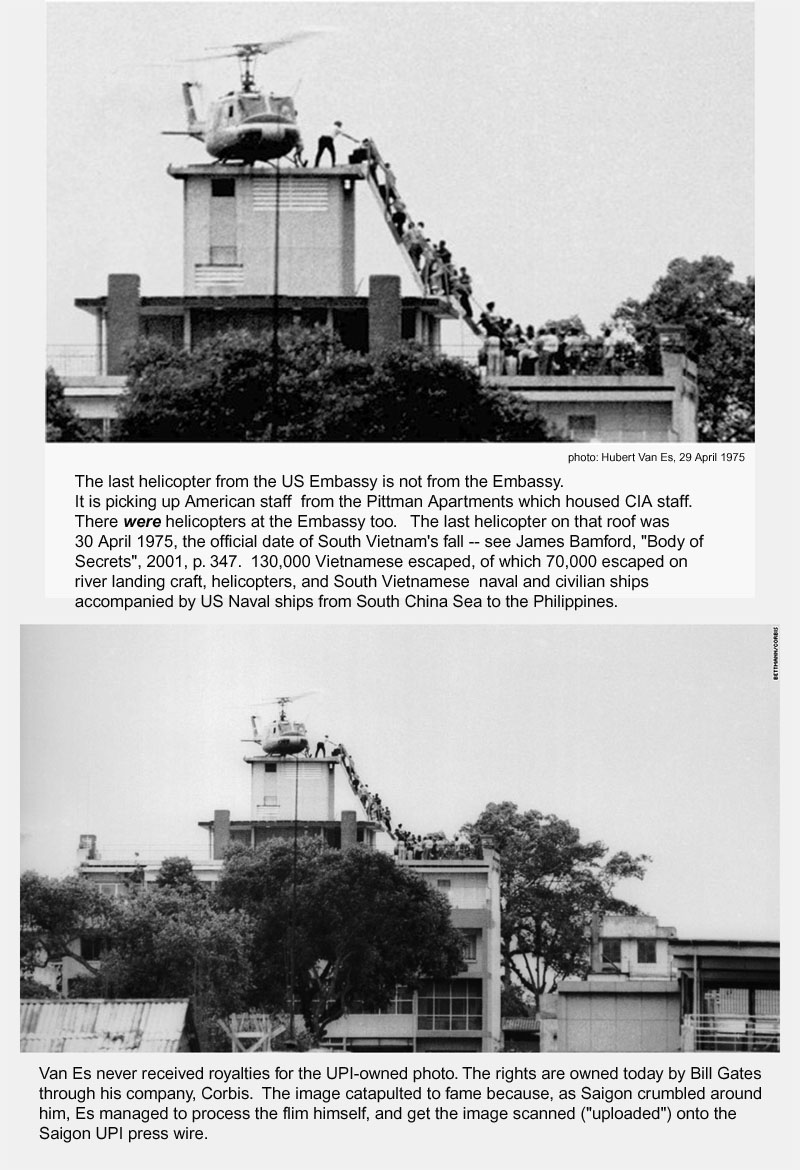
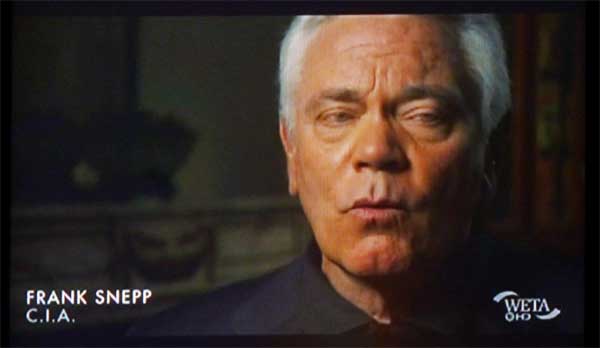
Snepp was on one of the last helicopters out of Saigon in 1975, and got
the CIA's Intelligence Medal of Merit when he got home, but resigned
shortly thereafter, upset at the Agency's refusal to rescue Vietnamese
left behind in the pull-out, and its refusal to acknowledge the
mistakes made.
His book "Decent Interval" is a classic account of the fall of Saigon
(. . . "An Insider's Account of Saigon's Indecent End Told by the CIA's
Chief Strategy Analyst in Vietnam").
The Agency pursued Snepp to the Supreme Court, but succeeded only in
suppressing Snepp's earnings (by then, $300,000), not the book.
It intrigues me that every other CIA agent in Burns' film is an "Army
adviser", but Snepp, persona non grata at Langley, is "C.I.A."
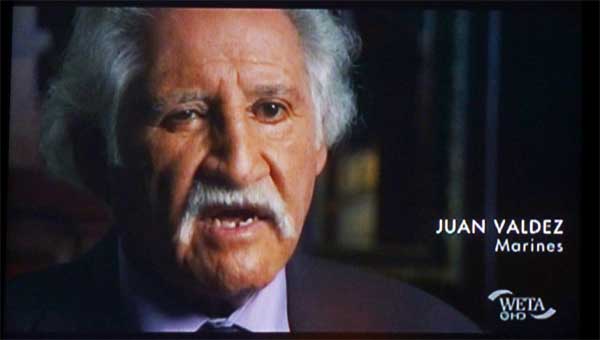
Master Sergeant Juan Valdez -- The Last One Out, But No Time to Turn Out the Lights
Saigon is falling and Valdez has the only Marines in Vietnam; he is
commanding officer for the Embassy security guards. He and his
team must extract Americans and their South Vietnamese employees from
the crowd of over 10,000 people surrounding the Embassy. The
selection process is impossible -- the bodies clutch one another, all
want in.
Other Marines struggle to destroy classified materials, leaving some
behind – later reassembled by the North Vietnamese to create a hit list
of collaborators. They couldn't burn the cash stash for bribery
and payoffs fast enough either. Ten years previously, the single
CIA case officer I know best (Dad) carried $300,000 at a time to
Italian labor unions; he did the same in Vietnam and that's only the
labor program, not payoffs to the military or politicians. The
direct cost of the war in 2011 dollars is 738 billion. A billion
dollars fits onto 12 fork-liftable shipping pallets, each stacked 3 1/2
feet high. Dad got $300,000 into his briefcase (it bulged).
Let's hope the Marines didn't have $1B.
President Ford runs out of patience, orders Ambassador Martin out
(helicopter ca 4AM 30April1975; the fool wanted the romance of being
last to leave). Then Ford commands the Americans to abandon their
Vietnamese staff. So Valdez gets everyone up on the roof and out
on another flight just before 7AM.
Now he and his team of 10 remaining Marines are the only ones
left. Period. Valdez watches as the gates are broken and
South Vietnamese flood the Embassy courtyard. One hour, no
helicopter, no way to make radio contact. They plan to make a
final stand on the roof, when they hear a helicopter. The mob has
driven a fire truck through the Embassy's massive teak front doors and
only a final teargas grenade holds them off as they board. Almost
blinded by teargas himself, the pilot lifts off and climbs out of small
arms fire range.
Valdez was among the first Marines to land in 1965, and he is the very last American to board a helicopter on 30 April 1975.
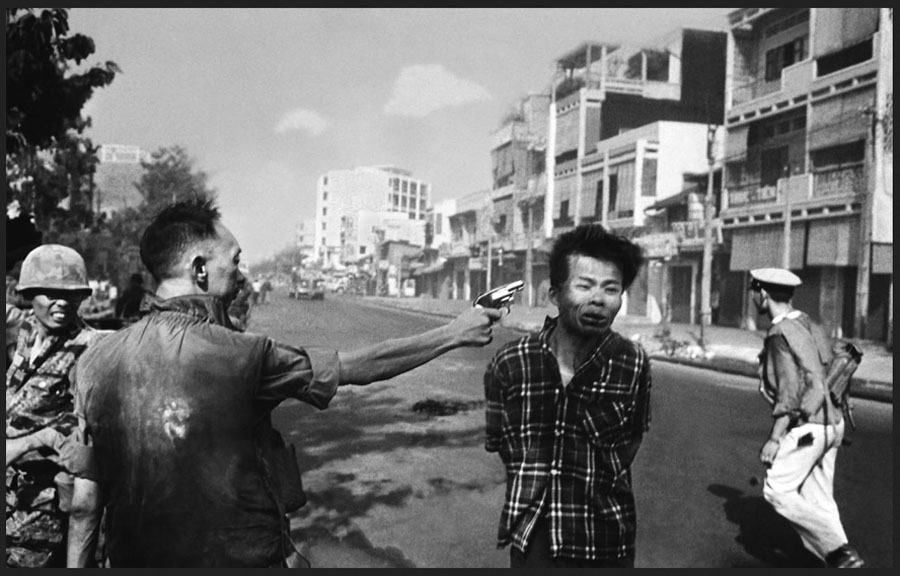
Assassination squads ran through major cities to find their assigned
targets in the ruling elites as the Tet Offensive kicked in on 30
January 1968. In Saigon, this unit commander was found standing
over a pile/grave of police officer family members. General Nguyen Ngoc
Loan assassinated him, Nguyen Van Lem, on 1 Feb 1968. Eddie Adams'
photo above won a Pulitzer next year.
The footage of NBC camera man Vo Suu that was aired in 1968 but has hardly
been seen since, continues on with the force of the bullet hurling Lem to
the street, where his brains come out on the pavement from the exit
wound, lying thankfully hidden against the ground.
Ken Burns and Lynn Novick are proud that their producer Sarah Botstein
was able to persuade NBC to let Americans see this again, with the
agreement that only the exact frames that had been aired almost 50
years
ago would be shown. Enjoy.
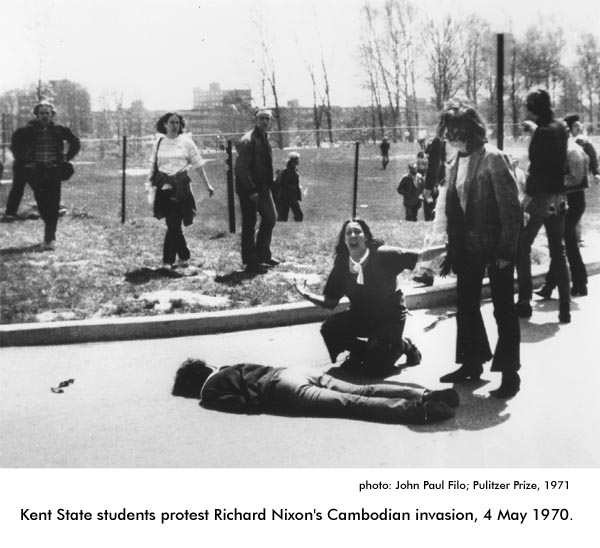
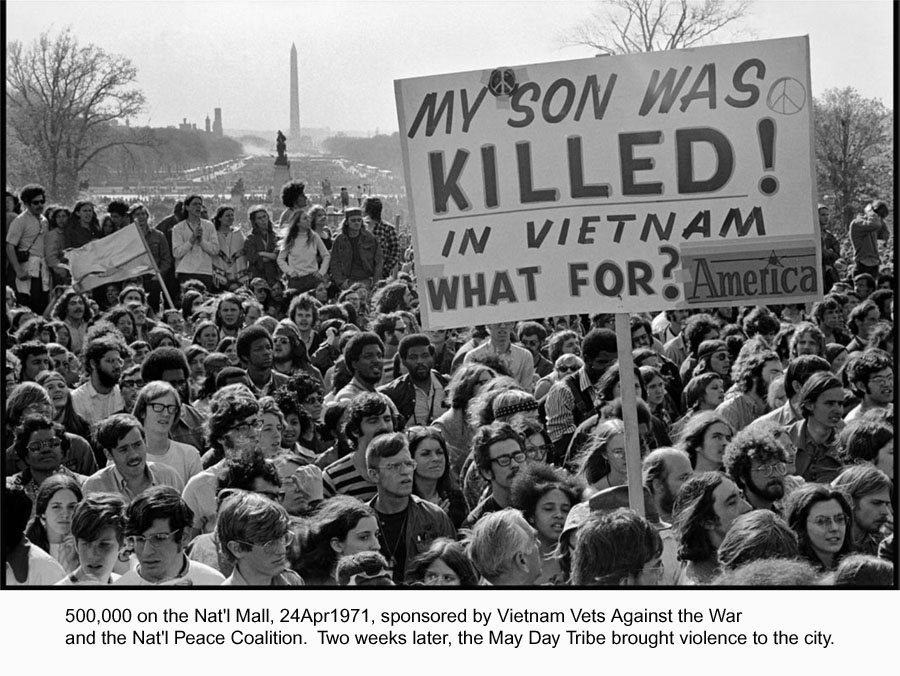
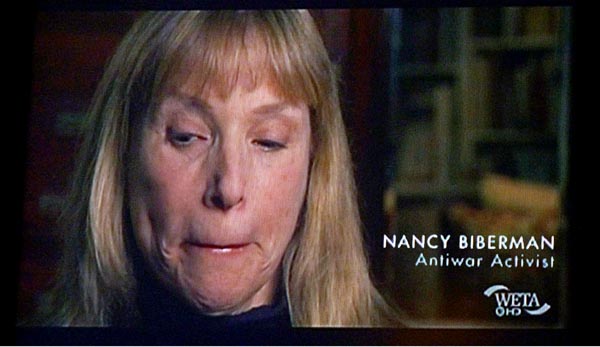
"In sharing the film, one North Vietnamese soldier said that he had
always seen the American demonstrations as a sign of our weakness. And
now seeing the film, he understood that it was a sign of great strength
that Americans could voice their own opinions. And I think we can take
a lesson from them - that they remind us that what we consider this
terrible time when we're ripped asunder now in retrospect represents to
them, and perhaps also to us, a time when democracy actually
functioned, . . . "
--Ken Burns, to Lulu Garcia-Navarro, National Public Radio 9/2017
Nancy Biberman: but ". . . the horrible things that we said -- we
called them 'baby killers' . . . I can only say to them but remember,
we were kids too, . . . .
[hesitates]
It grieves me today, it pains me . . . And I would like to say I'm
sorry, to say now, I'm sorry." [breaks down on
camera]
Nancy Biberman has worked for thirty years on increasing affordable
housing and driving community development in New York City. She
emphasizes the need to give low income families more equity in their
own homes.
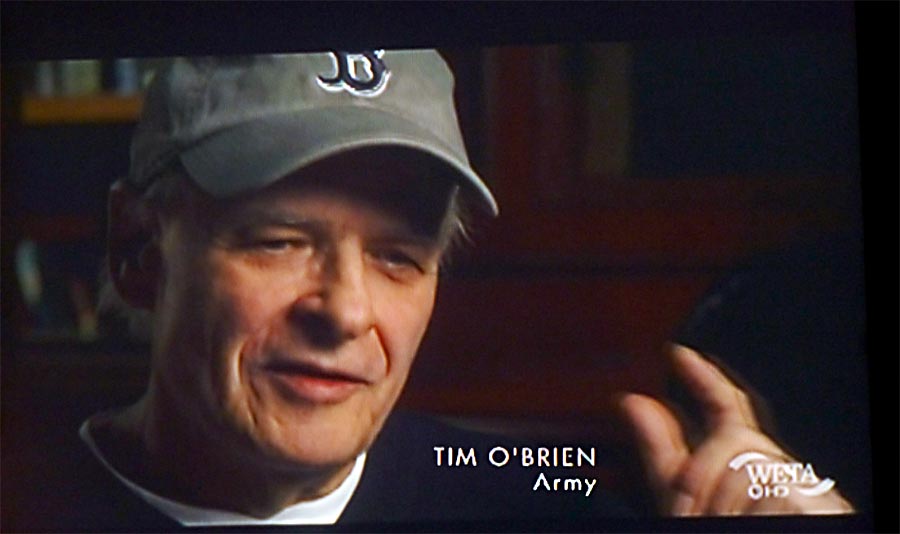
Author, "The Things They Carried".
"That book, which is almost all invented, is emotionally closer to what
the war actually was with me The ambiguity of the experience is
captured through fiction. This incredible sense of ambiguity."
"We celebrate the westward expansion of this country, but we rarely
discuss the wholesale slaughter of Native Americans. We celebrate
militarism, but hardly discuss incidents like Mai Lai. It's about
knowing what to question, and what to find wrong."
I asked O'Brien what watching these scenes was like for him. "It makes
me cry," he said. "I can't stop crying. I can't stop
thinking of what a waste it all was."
Taking turns, they carried the big PRC-77 scrambler radio, which weighed 30 pounds with its battery.
They
shared the weight of memory. They took up what others could no longer
bear. Often, they carried each other, the wounded or weak.
They
carried infections. They carried chess sets, basketballs,
Vietnamese-English dictionaries, insignia of rank, Bronze Stars and
Purple Hearts, plastic cards imprinted with the Code of Conduct.
They
carried diseases, among them malaria and dysentery. They carried lice
and ringworm and leeches and paddy algae and various rots and molds.
They
carried the land itself—Vietnam, the place, the soil—a powdery
orange-red dust that covered their boots and fatigues and faces. They
carried the sky. The whole atmosphere, they carried it, the humidity,
the monsoons, the stink of fungus and decay, all of it, they carried
gravity.
"The Things They Carried" was published in 1990. It has sold two
million copies. 2,500 readers felt compelled to add their
comments to a growing list of "reviews" where the book is sold on
the Amazon website.
After
eighteen hours of documentary, it was this passage, Tim reading this passage, that
was the prayer offered, and so I offer it to you.
--end
top
home for this Website, such as it is
a happier Website, travelogues - Germany, Oz
To find this essay, search BURNS VIETNAM MUGSHOTS -- if your friends have good criticisms, share them!
jerry_stillstanding@nelsonic.org
revised 12May2018 spelling, photojournalists tribute
26Apr2018 email address, search terms

















































